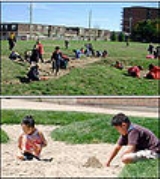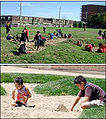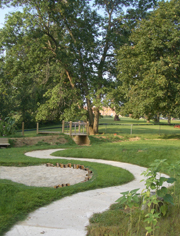
Playscape
Encyclopedia
Playscape is the term used by landscape architect
s and designers who specialize in designing and building playspaces that look and feel like a natural environment.
For a playground
to be considered a "playscape" the space should be as natural as possible, with as little man made components as possible. Using native plants, rolling hills, lots of trees; playscapes represent a natural place such as a forest. Playscapes are designed with the intent of bringing children and people back to nature. Playscapes offer a wide range of open-ended play options that allow children to be creative and use their imagination. Playscapes offer a wide range of developmental benefits to children, rehabilitation programs and all people in general.
Playscapes have a fraction of the number of child injuries compared to standard playgrounds
with play structures. The most frequent injury to children on playgrounds is a fracture of the upper limb resulting from falls from climbing apparatus's (Fissel, 2005). The second most common cause of injury to children on playgrounds is falls from slides (Fissel, 2005). Fall heights are the largest safety issue for most safety inspectors.
Playscapes combat the issue of fall heights by using topography changes for children to climb and experience changes in height. Companies in Canada have made strides in reducing fall height by using topography
as a main feature in their designs. Topography changes allow designers to be creative when placing components in the playscape.
They are also used in horticultural therapy for rehabilitation of mental and/or physical ailment. They increase participation rates and decrease absenteeism
, decrease bullying, decrease injury rates, increase focus and attention span and help with social skills in schools (Fjortoft 2000, Wells, 2000 and Malone, 2003). Playscape have shown to increase children's level of physical activity, and motor ability (Fjortoft and Sageie, 2000). Playscapes are found to be very beneficial in the growth and development of children both mentally and physically. Cognitive development, focus, attention span
and social skills are all improved (Wells, 2000 and Malone, 2003).
Playscapes have no central location, or prescribed area of play. They are open-ended spaces that entice children to use their imagination and creativity. Playscapes do not prescribe in an area that encourages a physical hierarchy thus, reducing bullying and competition based on physical strength and ability (Herrington and Studtmann 1998).
Playscapes are not limited to public parks and schools. Select hospitals in Sweden and North America have playscapes on their facility. Hospitals use playscapes for horticultural therapy, which has proven to increase emotional, cognitive, and motor improvements and increased social participation, quality of life and well-being (Soderback et al., 2004).
Since 2006 Landscape Architects Adam White and Andrée Davies have pioneered the Playscape approach to play space design in the UK. They have won a number of design and community engagement awards each year for their work, these have included: RHS Gold Medal and BBC Peoples Choice Award, Landscape Institute Communication & Presentation Award, Horticultural Weekly Award and Children and Young Peoples Services Award for genuine community design engagement.(http://www.bbc.co.uk/gardening/flower_shows/hampton_court_2007/gardens_community.shtml).
In 2009 they have won the award for the 'UK's Best Play Space' at the Horticultural Week Awards and have been short listed for Decembers BALI Construction Awards and the UK Landscape Architects Design Awards. In 2007 and they were reported as ‘ahead of the game’ in their profession by the Sunday Telegraph and in June 2009 they were profiled in The Times for their recently completed Lyric Theatre Roof Terrace Garden in Hammersmith, London
"The name Playscape aims to emphasize that the total environment can have play value, not just a corner of a park or garden. Think grassy mounds, innovative planting, timber decking, trees, water, bridges and boulders complemented by modern well designed play equipment and you've got Playscape: an exciting and challenging space to play with unlimited creativity and imagination." Adam White CMLI (http://www.youtube.com/watch?v=DqoG_W_ET9k).
 ]"Natural playgrounds" are play environments that blend natural materials, features, and indigenous vegetation with creative landforms to create purposely complex interplays of natural, environmental objects in ways that challenge and fascinate children and teach them about the wonders and intricacies of the natural world while they play within it.
]"Natural playgrounds" are play environments that blend natural materials, features, and indigenous vegetation with creative landforms to create purposely complex interplays of natural, environmental objects in ways that challenge and fascinate children and teach them about the wonders and intricacies of the natural world while they play within it.  The technological age has changed the ways in which children play, arguably contributing to childhood obesity. It is therefore up to parents, communities and schools to re-introduce to children what it means to play in the outdoors. (Flaherty, 2009)
The technological age has changed the ways in which children play, arguably contributing to childhood obesity. It is therefore up to parents, communities and schools to re-introduce to children what it means to play in the outdoors. (Flaherty, 2009)
Play components may include earth shapes (sculptures), environmental art, indigenous vegetation (trees, shrubs, grasses, flowers, lichens, mosses), boulders or other rock structures, dirt and sand, natural fences (stone, willow, wooden), textured pathways, and natural water features.
Landscape architect
A landscape architect is a person involved in the planning, design and sometimes direction of a landscape, garden, or distinct space. The professional practice is known as landscape architecture....
s and designers who specialize in designing and building playspaces that look and feel like a natural environment.
For a playground
Playground
A playground or play area is a place with a specific design for children be able to play there. It may be indoors but is typically outdoors...
to be considered a "playscape" the space should be as natural as possible, with as little man made components as possible. Using native plants, rolling hills, lots of trees; playscapes represent a natural place such as a forest. Playscapes are designed with the intent of bringing children and people back to nature. Playscapes offer a wide range of open-ended play options that allow children to be creative and use their imagination. Playscapes offer a wide range of developmental benefits to children, rehabilitation programs and all people in general.
Playscape Safety
Playscapes are designed to eliminate fall heights. Playscapes have rolling hills and fallen logs rather than a central play structure with monkey bars. Playscapes have much lower injury rates then standard playgrounds (Fjortoft and Sageie, 2000). By eliminating fall heights playscapes offer a safe alternative to play structures.Playscapes have a fraction of the number of child injuries compared to standard playgrounds
Playground
A playground or play area is a place with a specific design for children be able to play there. It may be indoors but is typically outdoors...
with play structures. The most frequent injury to children on playgrounds is a fracture of the upper limb resulting from falls from climbing apparatus's (Fissel, 2005). The second most common cause of injury to children on playgrounds is falls from slides (Fissel, 2005). Fall heights are the largest safety issue for most safety inspectors.
Playscapes combat the issue of fall heights by using topography changes for children to climb and experience changes in height. Companies in Canada have made strides in reducing fall height by using topography
Topography
Topography is the study of Earth's surface shape and features or those ofplanets, moons, and asteroids...
as a main feature in their designs. Topography changes allow designers to be creative when placing components in the playscape.
Developmental Benefits
Playscapes offer a wide range of benefits such as increasing physical activity, fine and gross motor skills & cognitive development.They are also used in horticultural therapy for rehabilitation of mental and/or physical ailment. They increase participation rates and decrease absenteeism
Absenteeism
Absenteeism is a habitual pattern of absence from a duty or obligation. Traditionally, absenteeism has been viewed as an indicator of poor individual performance, as well as a breach of an implicit contract between employee and employer; it was seen as a management problem, and framed in economic...
, decrease bullying, decrease injury rates, increase focus and attention span and help with social skills in schools (Fjortoft 2000, Wells, 2000 and Malone, 2003). Playscape have shown to increase children's level of physical activity, and motor ability (Fjortoft and Sageie, 2000). Playscapes are found to be very beneficial in the growth and development of children both mentally and physically. Cognitive development, focus, attention span
Attention span
Attention span is the amount of time that a person can concentrate on a task without becoming distracted. Most educators and psychologists agree that the ability to focus one's attention on a task is crucial for the achievement of one's goals....
and social skills are all improved (Wells, 2000 and Malone, 2003).
Design
Playscapes are not intimidating regardless of ability or fitness level.Playscapes have no central location, or prescribed area of play. They are open-ended spaces that entice children to use their imagination and creativity. Playscapes do not prescribe in an area that encourages a physical hierarchy thus, reducing bullying and competition based on physical strength and ability (Herrington and Studtmann 1998).
Playscapes are not limited to public parks and schools. Select hospitals in Sweden and North America have playscapes on their facility. Hospitals use playscapes for horticultural therapy, which has proven to increase emotional, cognitive, and motor improvements and increased social participation, quality of life and well-being (Soderback et al., 2004).
Since 2006 Landscape Architects Adam White and Andrée Davies have pioneered the Playscape approach to play space design in the UK. They have won a number of design and community engagement awards each year for their work, these have included: RHS Gold Medal and BBC Peoples Choice Award, Landscape Institute Communication & Presentation Award, Horticultural Weekly Award and Children and Young Peoples Services Award for genuine community design engagement.(http://www.bbc.co.uk/gardening/flower_shows/hampton_court_2007/gardens_community.shtml).
In 2009 they have won the award for the 'UK's Best Play Space' at the Horticultural Week Awards and have been short listed for Decembers BALI Construction Awards and the UK Landscape Architects Design Awards. In 2007 and they were reported as ‘ahead of the game’ in their profession by the Sunday Telegraph and in June 2009 they were profiled in The Times for their recently completed Lyric Theatre Roof Terrace Garden in Hammersmith, London
"The name Playscape aims to emphasize that the total environment can have play value, not just a corner of a park or garden. Think grassy mounds, innovative planting, timber decking, trees, water, bridges and boulders complemented by modern well designed play equipment and you've got Playscape: an exciting and challenging space to play with unlimited creativity and imagination." Adam White CMLI (http://www.youtube.com/watch?v=DqoG_W_ET9k).
Natural Playground


Play components may include earth shapes (sculptures), environmental art, indigenous vegetation (trees, shrubs, grasses, flowers, lichens, mosses), boulders or other rock structures, dirt and sand, natural fences (stone, willow, wooden), textured pathways, and natural water features.

